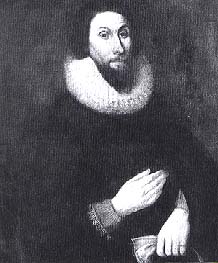
John Winthrop, Puritan leader of
Massachusetts Bay Colony

I. European Models for Colonizing America
A. Spain--colonization with conversion
1. Earliest colonies in America
(St. Augustine 1565, Santa Fe 1610), though most outposts were
destroyed by Indian attacks
2. Spain turned to Franciscan missionaries to control
Indians, placing land grants in the hands of encomenderos. Spanish rule was
cruel, used slavery, and was limited, except for New Mexico. California
was virtually ignored until the late 1700s.
3. By 1560, the main goal of Spanish colonial policy was keeping
other Europeans from establishing colonies.
B. France--fur-trading empire
1. Indian wars developed as tribes fought
for the French fur trade.
2. French missionaries did not enslave Indians and attempted to limit
trading of alcohol
3. Though few in number, French settlers brought diseases that wiped
out
up to 90% of the Indians in the Great Lakes region.
C. Netherlands--commerce and farming
1. Colonization was slow and
small-scale, with only one proprietor (Rensselaer) able to attract 50
tenants
2. Rejecting representative rule, the Dutch lost the settlement
of New Amsterdam (New York) to the British in 1664
D. The English model--tobacco and settlers
1. Causes for English Colonizing in
America (See Colony Chart for
quick-reference guide to colonies)
2. Changes in English economy.
a. Rise of merchant class to provide business leadership and
wealth for colonial investment.
b. Joint-stock company allowed for pooling of capital with limited risk.
c. Surplus population in cities as farmers were pushed off lands
converted to sheep herding
3. Protestant Reformation
II. Jamestown and Virginia
2. Convert Indians to Christianity
3. Find a passage to the Indies
B. Early group suffered from laziness, starvation, and malaria. Saved by leadership of John Smith and enterprise of tobacco planter John Rolfe, who perfected methods of raising and curing tobacco
1. Tobacco brought capital and workers to Virginia. Exports rose
to 10 million pounds by 1660. The Virginia Company provided land,
established a headright system and courts, and allowed self-government
by planters.
2. Problems with tobacco farming
C. Bacon's Rebellion
1. Attacks on Indians by poor whites led to the killing of 300
whites. A defensive military strategy failed as Nathaniel Bacon
attacked Indians and then seized control of the colony.
2. Bacon died in 1676, but his followers pushed for tax cuts, voting
rights for landless whites, and and end to corruption.
3. The planter class sought to limit the number of white servants who
might rebel again, thus opening the way for slavery's expansion.
D. Contributions of early Virginia
III. New England Colonies--settled by families
B. Puritans established Massachusetts Bay in 1630 (John Winthrop and 900 settlers) for economic and religious reasons.
Feldmeth, Greg D., "Colonial Beginnings," U.S. History Resources
<http://www.polytechnic.org/faculty/gfeldmeth/USHistory.html/lec.col1.html>(Revised
21
June 2004).
 Back to Outlines
& Charts Index
Back to Outlines
& Charts Index
 Back to U.S. History
Resources main page.
Back to U.S. History
Resources main page.